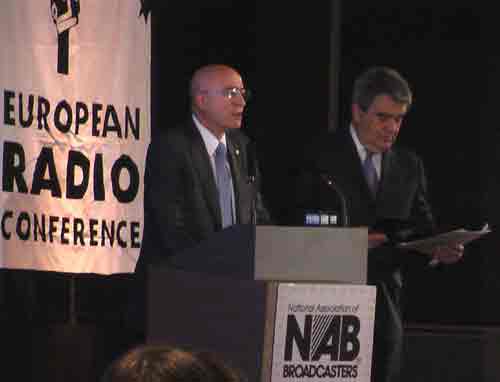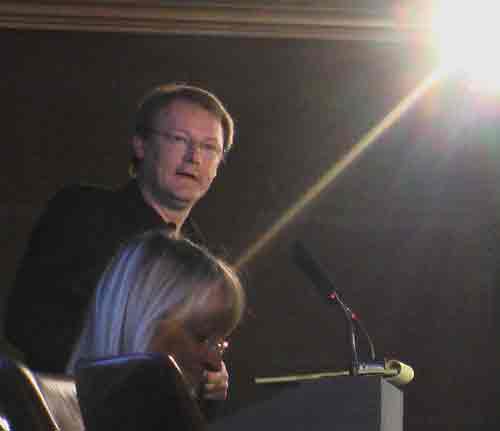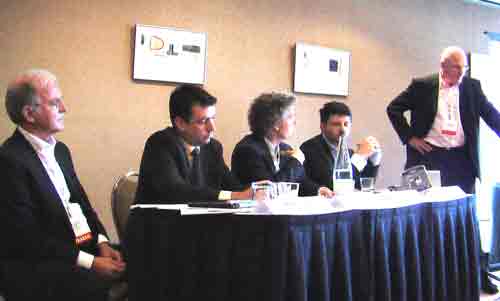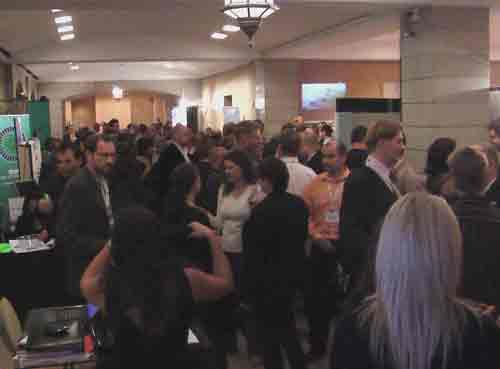Bericht vom Montag, den 5. November 2007, dem ersten Tag der NAB European Radio Conference in Barcelona, Katalonien, Spanien im ARTS-Barcelona Hotel.
Das Ganze beginnt im grossen Hotel-Saal mit vielen runden Tischinsel, an denen sich die Teilnehmer zum Frühstück versammeln, während auf der leider nur unzureichend ausgeleuchteten Bühne die Honoratioren auftreten und ihrerseits weitere Ehrengäste im Raum willkommen heissen.
Nach der Begrüssung durch den NAB-Verantwortlichen John C. David,
Executive Vice President Radio ("Willkommen in Barcelona, wo wir uns ein einer völlig veränderten Stadt nach 12 Jahren wieder gerne einfinden") und dem "Conseller" des "Departament de Cultura i Mitjans de Communicaió", Joan Manual Tresserras i Gaju ("Katalonien ist das Königreich der Konvergenz") ...

... werden im sogenannten LEADERSHIP FORUM in der Moderation von Emanuel Legrand zwei Radiomacher eingeladen, die als zukunftsweisende europäische Hoffnungsträger für die gesamte Branche vorgestellt werden:

– Nathalie Schwarz, Director of Radio, Channel 4 radio
Sie plädiert für hochwertige Inhalte, gekoppelt mit hochgradig interaktiven Anwendungen, und einem grossen Aufwand an Recherchen über das zukünftige Publikumsverhalten - das sei die "magic formular", mit der man bei Channel 4 die BBC nun auch auf dem Radio-Markt angreifen wolle.
&
– Bartosz Hojka, General Manger, Agora Radio Group
In seiner Beschreibung wird klar, dass die privaten Radiomacher vor einer ganz neuen Herausforderung stehen: Nicht nur mit der Einführung des Privatradios als solchem, sondern vor allem mit der gleichzeitig aufkommenden Veränderung der Hör-Gewohnheiten der Konsumenten.
Wir werden viel Fehler machen und sind mit dem aktuellen Musikangebot erst am Anfang unsers Bestrebens, sagt Bartosz, das Ziel sei es, ein Programm zu machen, das beim Publikum ankommt und zugleich die Erwartungen der Investoren erfüllt. "Wir müssen dahin gehen, wohin sich unser Publikum bewegt."
Ob denn das Musikformat im Radio angesichts der iPod-Generation überhaupt noch eine Chance habe?
Ja, sagt Nathalie: bis zu 70 Zugriffe der jungen Leute zu den Programmangeboten beziehen sich zunächst auf das Radio und dann erst auf weitere / andere Quellen. Und dieses Potenzial werde man aktiv pflegen und bedienen.
Ja, sagt Bartosz: vor allem dann, wenn wir diese Inhalte gut verpacken und es gelingt, diese durch attraktive Persönlichkeiten hinter dem Mikro rüberbringen zu können.
Die ursprüngliche Aufgabe des Radios, Hörer"gemeinden" zu schaffen, werde sich in neuer Form auch in Zukunft wiederholen. Gerade in dieser Zeit der Digitalisierung sei es notwendiger als je zuvor, neue Beziehungen des Vertrauens herzustellen. Aufmerksamkeit und Vertrauen, das seien die Schlüssel für den Erfolg des Radios in Zeiten von digitalen, konvergenten Plattformen.
Und wie es mit der Nutzung der mobilen Empfangsgeräte bestellt sei, so die Frage.
Nathalie: bereits heute haben mehr als 50% der Jugendlichen einen Radioempfänger in ihrem mobilen Telefon, von den 14-17-jährigen sogar über 70%. Die nächste Perspektive, das seien die DAB-tauglichen mobilen Empfangsgräte.
Bartosz: alles deutet darauf hin, das die Anbindung der mobilen Endgräte an den Radioempfang und an das Internet von höchster Bedeutung sei.
Beide der eingeladenen Gäste sind sich einig, dass es notwendig sei, grosse Risiken einzugehen, da derzeit noch keiner wisse, wie sich die Zukunft dieser Nutzung wirklich entwickeln werde. Ja, die Risiken seien heute so hoch wie in jenen Tagen, als man begonnen habe, das Privatradio in Europa einzuführen.
Das Radio in 5 Jahren?
Bartosz: Es wird eine Vielfalt der Kanäle geben; die Persönlichkeiten hinter dem Mikro werden den Markt steuern; die mobilen Endgeräte werden die wichtigsten Empfangsgeräte sein. Und in fünf Jahren werden wir schon alle "terribly rich" sein.
_Nathalie: Radio soll mit Zuversicht in die Zukunft schauen. Man wird auch nicht alles über den Haufen werfen können. Aber man wird sich über alle möglichen Plattformen und Communities verbreiten. Die kommerziellen Partner werden sich erheblich umstellen müssen und neue Modelle erproben. Das gilt auch für die Technolgie-Partner.
Das nachfolgende Geschehen war in die folgenden thematischen Gruppen aufgeteilt [1]
Programming
MUSIC – GETTING IT RIGHT FROM START TO FINISH
Time: Monday, 10.40 – 11.40
Speakers: Mike Shepard, Pinnacle Media Worldwide; and Ken Benson, Pinnacle Media Worldwide
How do you get the music "right"? Attendees will learn to implement a strategically sound music system from the ground up. This session will start with a strategic perceptual study utilizing clustering to determine the criteria for your station. It will continue with a Music Test based on those criteria, and it will conclude with a basic lesson in music architecture and clock design.
"RHYTHMIC AC" IS MAKING NOISE ON BOTH SIDES OF THE ATLANTIC. WHAT IS IT, AND HOW MIGHT IT WORK FOR OR AGAINST YOUR STATION?
Time: Monday, 12.00 – 13.00
Moderator: Steve Casey, Steve Casey Research
Panelists: Alan Burns, Consultant, and Francis Currie
In London, rhythmic-based Heart FM has clearly clicked with listeners: it’s the number one station in this giant market. In the US, consultant Alan Burns has launched a slightly hotter version of rhythmic AC called "MOViN", which is already on the air and growing in many of the largest markets.
Heart’s Brand Programme Director Francis Currie, and US/European consultant Alan Burns will share insights including the theory, challenges, and successes of this new variety of adult contemporary radio. How is it different from "hits" formats and from "typical" AC stations? Is it a strategic opportunity or threat for you? Find out in this session moderated by international programming research consultant Steve Casey, who has worked with more than 50 stations in Europe.
TRACKING MUSIC BURN, MINUTE BY MINUTE
Time: Monday, 14.45 – 15.45
Speaker: Martin Molmen, P4
With electronic measurement, new opportunities have opened for radio programming. Since April 2006, Norway has been using Portable People Meter (PPMSM) measurement with minute granularity as their national currency. P4 has now started to track the "burn" for every single song, every minute of every day. By looking at the ratio at which the audience turns off the radio or switches the channel during particular songs, this opens up a whole new area of music planning and data to aid in programming decisions.
HERE WE GO AGAIN: POP’S 10-YEAR CYCLE
Time: Monday, 16.15 – 17.15
Moderator: Steve Davis, Zapoleon Media Strategies
Panelists: Guy Zapoleon, Zapoleon Media Strategies, Tom Poleman, Clear Channel
In the beginning there was Elvis. Explore the Zapoleon Music Cycle theory and examine how music’s ten year cycles reflects pop culture, influences our lives, creates and eliminates formats and impacts how our radio stations are programmed. Noted consultant and music theorist Guy Zapoleon of Zapoleon Media Strategies, VP of Programming for Clear Channel and Z100, New York programmer Tom Poleman and Zapoleon Media Strategies consultant Steve Davis explain how to make sense of the patterns of Pop music cycles and how understanding the basics of the cycles helps make for better programming. See how to maximize your station when the cycle is strong and how not to get off track when the cycle is low. This is a fascinating session you will not want to miss.
Management
BUILDING A FUTURE FOR SPANISH RADIO
Time: Monday, 10.40 – 11.40
Moderator: Raúl Domingo de Blas, KnowMedia
Panelists: Ramón Mateu, Director General, Uniprex; Raul Rodriguez, Director General, Cadena SER; Santiago González, Director RNE
Leading radio companies in Spain that are integrated in multimedia groups face significant challenges ahead: new FM concessions, multimedia integration and competition, technological changes in the audio-visual market, new habits of listener consumption and the overall changes in the relationship with the radio listener. This unique session will gather Spain’s leading radio executives to analyze the Spanish radio business model, and its present and future challenges.
DOES RADIO HAVE A 10% PLUS MEDIA SHARE IN YOUR COUNTRY?
Time: Monday, 12.00 – 13.00
Speakers: Jim Receveur, Radio100 FM; Bob Cohen, Clear Channel; Jan Willem Brugenwirth, Radio 538; Nik Goodman, Nik Goodman Media Consultiing
With radio stations in New Zealand and Holland getting over 10% of the media spend there is huge potential for radio growth. But why are media shares are so different from country to country? Hear how the world market leaders have tackled agencies and direct sales, non traditional revenue in different ways (e.g. SMS, MSN, Internet, etc.) and have used new media to increase radio share and not decrease.
NEVER WONDER WHAT TO DO NEXT - THE ROADMAP TO OBJECTIVE PROBLEM SOLVING
Time: Monday, 14.45 – 15.45
Speakers: Paul Weyland, Paul Weyland Communication Strategies
This informative and entertaining session shows you precisely what you need in order to deal effectively with any and every problem that you encounter in your broadcast business and even in your personal life.
Armed with this simple but powerful method, you’ll have the skill and the confidence to identify and solve problems quickly and concisely, take control of chaotic situations, embrace change, take better advantage of opportunities that come your way and achieve positive results from negative circumstances.
Managers will learn how to achieve goals faster, improve internal and external communication, make laser-sharp decisions, encounter fewer surprises and turn ordinary employees into creative thinkers. Salespeople will learn how to get more appointments with key decision makers, write concise proposals that clients really want to read, close bigger deals and become indispensable client resources.
EXECUTION EXCELLENCE - THE SECRET TO GETTING THE BEST STRATEGIC SALES AND MARKETING RESULTS
Time: Monday, 16.15 – 17.15
Speakers: Greg Worthington, Austereo
How does Austereo, whilst operating only 20% of Australia’s capital city stations, continue to dominate the share of radio revenue in one of the world’s most competititve radio markets?
The philosophy behind success is simple - “execution excellence.” As the battle for ratings continues, the way advertising agencies and clients use radio is changing globally. The method in which radio stations train their sales and marketing teams and structure their internal communication processes to meet these demands is critical in ensuring revenues can be maximised without compromising programming brand values.
Greg Worthington will show examples of how stations have been able to procure higher NTR and NSR across multiple platforms through a “world’s best practice” philosophy, and how creative cutting edge S&P can enhance station and network programming goals.
Sales/Marketing
BRANDING YOUR STATION’S WEB SITE
Time: Monday, 10.40 – 11.40
Speakers: Abbe Cherkaoui, Strategy Group, Mathieu Sibille, NRJ
Building a station brand is one of the most challenging tasks marketing, promotion, and station managers face today. Branding, especially for a radio station, is based on a value created in the mind of the listener; when the station loses value, they lose a listener. Programmers, marketers, and managers must ensure and maintain the brand image… and they must now do this online.
"WORD OF MOUSE" MARKETING
Time: Monday, 12.00 – 13.00
Speaker: Doug Harris, Creative Animal
As the demand for "return on investment" increases and advertising and marketing budgets decrease, broadcasters must find cost–effective ways to promote their products to a distracted audience. This world premiere presentation would include an examination of new developments in "social media" (such as blogs, YouTube, MySpace, Facebook, and European equivalents) that allow broadcasters the opportunity to persuade online communities to become passionate advocates of radio stations and their personalities. This session will also review multiple case studies of stations that have used modest budgets to deliver big results.
RADIO BUSINESS: DATA CASTING
Time: Monday, 14.15 – 15.45
Speaker: Eugenio La Teana, RTL Italy
For most radio broadcasters the main source of revenue is advertising. BUT the digital revolution, the Internet, and new multimedia applications offer radio broadcasters new opportunities to earn income, completely changing the traditional business portfolio.
This session will cover the additional data services that are available today with digital radio, in particular with DAB (Digital Audio Broadcasting) and DMB (Digital Multimedia Broadcasting). It will also discuss why the introduction of new audio coded technology (DAB+) is so important in terms of ensemble service space.
ADVERTISING RESTRICTIONS IN EUROPE: IS ADVERTISING BECOMING “TOXIC”?
Time: Monday, 16.15 – 17.15
Speakers: Frederik Stucki, Malte Lohan, Oliver Gray
Advertising is a commercial practice under increasing pressure and scrutiny in the EU as more stakeholders consider it to be negative for society. Over the last few years, several EU directives have come into force limiting the advertising of specific products, like tobacco, in the EU Member States. The benchmark for advertising-related directives is no longer the “average consumer” but the “vulnerable consumer.” European Institutions increasingly blacklist advertising practices or product groups that they identify as harmful. This directly and severely impacts commercially funded radio broadcasters.
Discover the current and upcoming threats, and the radio industry’s plans to counteract: What are the main advertising areas and product groups likely to be impacted by these EU bans and restrictions? What are the responses to be considered by the radio broadcasting Industry?
Workshops
BUILDING SUCCESFUL RADIO IN EMERGING MARKETS
Time: Monday, 10.40 – 11.40
Speakers: Mikhail Eydelman; Bert Kleinman, Bert Kleinman Programming Inc.; Larry Rosin, Edison Media Research; Paul Shylko
This workshop will focus on developing programming that is effective and successful in the developing markets (e.g. Eastern Europe, the Middle East, Africa and Asia). We will explore how to build programming teams and management (especially in situations where little indigenous talent exists), how to perform and evaluate effective research to determine the best programming strategies, and how to sustain success in the various environments that exist in markets where competitive, commercial radio is in the earlier stages of development.
Each of the panelists has extensive experience in this challenging environment and will draw on case studies to provide attendees with step by step practical advice on how to design, launch and grow successful stations in these unique situations. Among the subjects covered with special emphasis on the difficulties faced in developing markets will be:
Designing a comprehensive research program within budgetary constraints
Working with local "experts" who insist they "know the market"
Staff recruitment and training (local vs. visits to stations overseas)
The impact of format-based vs. program-based stations
Innovative methods of audience involvement
Developing a successful launch strategy
Affording a continuing research program - do you dare "do it yourself"
CREATING A MULTI-MEDIA BRAND: HOW RADIO SHOULD USE NEW TECHNOLOGIES AND PLATFORMS TO CREATE NEW CONTENT, NEW COMMUNITIES AND EXTEND THE BRAND
Time: Monday, 12:00 – 13:00
Speaker: Pat Welsh, Pollack Media Group
Multi-platform producer, Pat Welsh, Senior Vice President/Digital Content, Pollack Media Group, will divide the audience into teams and provide each team with an original element of radio content. The teams will be asked to introduce the content into new areas.
Presenters in music, sports, comedy and personality will play an important part in the session, and will disclose some interesting new revenue opportunities.
EUROPEAN DIGITAL RADIO – WHICH PLATFORM, WHICH DIGITAL PIPE?
Time: Monday, 14.45 - 15.45
Moderator: Paul Brown, RadioCentre
Panelists: Peter Senger, DRM, Martin Liss, Mobiles Fernsehen Deutschland GmbH, Frank Johannsen, ARD, Dan D’Aversa, RTL Group Digital Radio Strategy
The European Commission appears to favor DVBH as the broadcast platform for digital mobile broadcasting in the future: can or will Europe opt for a single solution? Italy has plumped for DMB, the UK presses forward with DAB: are they dotty? Is it possible for Europe to support more than one digital broadcasting pipe? Is one better than another? Why? Won’t DRM be a better solution than multiplexing for many European broadcasters? Does radio need a guarantee of its own digital broadcasting space? Should radio just ride on the back of television or telecom ambitions? Can manufacturers provide receivers at the right price? Is a digital broadcasting pipe necessary at all given mobile broadband developments?
Paul Brown vom RadioCentre macht in seinen einleitenden Bemerkungen klar, dass DAB, DVBH und DAB mit MPEG2-Komprimierung, DMB und DRM sich mit ihren Entwicklungen sich trotz ihrer technischen Erfolge gegenseitig im Weg zu stehen scheinen. Er macht daher klar, dass er sogar die Position der EU-Kommissarin versteht, die hier Klarheit schaffen will.
Dan D’Aversa, RTL Group Digital Radio Strategy, beschreibt seinen Sender als den Stadtalter der Pioniertaten in der Radio-Welt.
Heute wird als Beispiel aus Deutschland das Bertelsmann-Produkt: "healthy living" als Audio-Produkt vorgestellt [2]
Was nach seiner Meinung ist das, was vor allem fehlt: Ein Rahmenplan, nach dem die Digitalisierung auf den nationalen und internationalen Märkten Einzug haben wird.
Mark Friend, Controller, Multiplatform & Interactive, BBC Audio & Music
In England wird vor allem deshalb DAB bevorzugt, da nur auf diesem Wege neue Inhalte in einer neuen Verpacktung vorgestell werden können - und werden. DAB-Nutzer sind mit 75% die besten Radio-Nutzer überhaupt. Auch in seiner Präsentation wird gezeigt, wie Radio in Zukunft "sexy & smart" sein kann - und die Grundlage für ein "social medium".
Dabei sei es angesagt, dass die Privaten und die Öffentlich-Rechtlichen vor allem dort zusammenarbeiten, wo es um die Verwendung der Technik steht.
Martin Liss, Director Content MFD [3]
Er spricht über "Plattform Business" und damit über eine Aufgabe, die im traditionellen Radiogeschäft nicht bekannt ist. MFD hält die Lizenz für DMB-basierte Programmangebote und bringt 3 Gruppen von Partnern zusammen: die Inhalteanbieter, die Techniklieferanten -Installateure und -Normwandler sowie die Vermarkter.
Damit sind sie in Deutschland die ersten Anbieter von TV-Programmen auf mobilen Endgeräten und einem Radio-Programm, das sich "watcha" [4] nennt. Sein Credo im Zusammenhang mit der Technologie-Diskussion: "We are a technology agnostic open plattform" - und seine Empfehlung: "persue with persistince, but play it nice...."
Peter Senger, seit 1998 Mitglied und Leiter des DRM Konsotiums
Er versucht die Forderung nach einem "single standard" in "seinem" System umzusetzen: Und dieses auch in Praxis unter Beweis zu stellen.
Dazu führt er Empfangs-Beispiele vor die er selber in ganz Europa "erfahren" hat: aus Bruxelles, aus Berlin, von der A4 in Deutschland [5], aus Köln und aus London von der M25.

In der anschliessenden Gesprächsrunde wird schnell klar, dass es nicht möglich ist, einfach abzuwarten, auch wenn man Gefahr läuft, in einem der Digi-Graves zu landen, in einem jener Gräber in das andere schon gefallen sind.
DMB-Investments, so sagt Martin Liss, sind sehr hoch und man rechnet mit einem Return of Invest in weniger - aber immerhin - 5 Jahren.
Peter Senger gibt bekannt, dass die Empfänger ab dem Jahr 2007 auch zu vernünftigen Preisen zur Verfügung stehen werden. Nach seinen Erfahrungen hören die Leute nicht über Satellit Radio. Und auch WiFi ist nicht Broadcasting.
Herr Liss verweist darauf, dass WiFi einen Rückkanal hat. Und das hat die Chance einer Killerapplication.
HD Radio ist in den USA ebenfalls dabei, sich zu engagieren. In den USA sind im Jahr 2006 mehrere einhunderttausend Geräte verkauft worden und die gleiche Zahl wurde schon im ersten Quartal des Jahres 2007 erreicht.
Zum Schluss der Debatte kam es dann zur Frage aller Fragen: DMB versus DVB-H. Um es kurz zu machen:
– DMB is enhanced DAB
– DVB-H is mulitfunktional.

Diese Serie von Veranstaltungen klingt aus mit einem Get-Together aller Teilnehmer und Aussteller, bevor es zur abendlichen European-Radio-Award-Verleihung kommt.
Editorischer Hinweis:
Es stellt sich heraus, dass die Erstellung und Redaktion dieses Textes zeitlich zu aufwendig ist, als dass dem Anspruch genüge getan werden könnte, wirklich in der vollen Chronologie der Events den ganzen Tag durchgängig mithalten zu können.
Dabei ist positiv zu vermerken, dass die Stabilität des Netzes hier im ARTS-Hotel so gut, dass es tatsächlich möglich ist, direkt und online diese Texte zu entwerfen, zu korrigieren und zu publizieren.
Und: es ist erstaunlich zu sehen, dass die Präsenz von Rechnern im Verlauf mehr als gering ist. Nach wie vor wird - wenn überhaupt - mit der Hand mitgeschrieben.
Es ist aber davon auszugehen, dass zumindest ein Teil der Präsentationen auf der Website nachzulesen sein wird. Aber machen wir und nichts vor. Das ist allenfalls interessant für diejenigen Personen, die an der Präsentation teilgenommen haben - oder?
